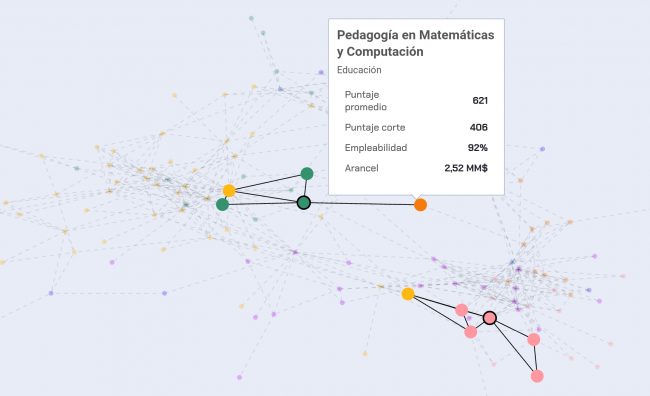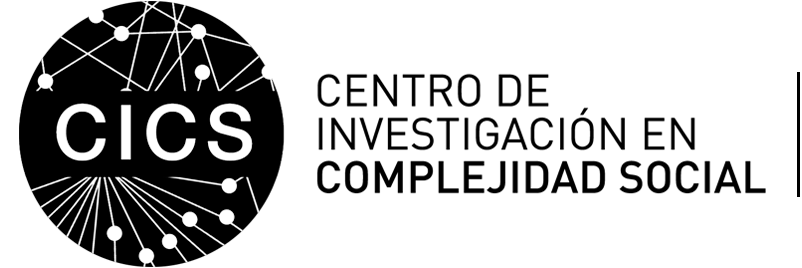A new platform reveals career alternatives using collective intelligence
Saturday, 11 December, 2021 | NEWSChilean physicist Cristian Candia-Castro developed a model that brings together the experience of 1.9 million people who have gone through the Chilean university application process. The Lixandria platform allows visualizing the relationships between two or more different careers to offer alternatives that fit the interests of the students.

Deciding what to study in the transition from High School to Higher Education is a crucial milestone in young people lives, but the abundance of options and the lack of friendly information can be overwhelming – even hinder the decision. Every year about 200 thousand young people in Chile go through the same process and, as they observed in Lixandria, their experience can provide valuable lessons to better decide which career to choose.
Based on the experience of 1.9 million historical applicants, Cristian Candia-Castro, researcher at the Data Science Institute of the Universidad del Desarrollo, created a platform for orientation, visualization and distribution of data on university careers that allows deepening and expanding the horizon of options that an applicant has when choosing which career to study.
“The information with which applicants choose which career to study comes mainly from family and friends, which limits the choice to a limited set of careers. This generates repercussions such as desertion, unemployment or wages lower than expected”, explains the physicist about the phenomenon called awareness set.
Candia-Castro adds that, with Lixandria, “we observed the preferences of previous applicants to broaden that spectrum, for example, biotechnology and medical technology, or audit accounting and statistical engineering are similar. In short, he offers a map beyond traditional careers, with a quick overview of options throughout the country, and even technical-professional career alternatives”.
In this way, if an applicant has interests in design and mathematics, he will be able to find a map that provides nine professional career alternatives related to these topics, and even technical career alternatives. Along with this information, comparative graphs of cutoff scores, tuition fees and employability are also generated for each study institution (both private and CRUCH members).
In addition, the free access platform allows you to compare preferred careers with information from various sources, such as the Ministry of Education, DEMRE and mifuturo.cl.
For those who still haven’t decided (and for those who do)
The platform allows, in three simple steps, to create and discover your own career map. First, the applicant must personalize his search for her by entering careers or areas of interest. Second, they will be able to explore all available options from options to order. Finally, they will be able to compare majors by college, cut scores, actual duration, fee, employability, or salary to make an informed decision.
This tool is especially practical if one considers that in 2021 only 16% of the applicants placed Medicine within their options, a very high percentage if one considers that the total number of generic careers, as recorded by the Ministry of Education, is 150. Something similar happens with Commercial Engineering, which added $4.5 of the applications.
Likewise, the platform evaluates the degree of relationship or similarity of the set of careers included in your application, an indicator that, due to its relationship with the dropout and retention of the system, is of particular relevance.
In this sense, Lixandria could help reduce university dropout rates, which in 2020 exceeded 17% in Universities associated with CRUCH and the Single Admission System, according to data from the National Education Council. This translates to approximately one in five students dropping out. In the case of non-affiliated Private Universities, this problem deepens, with a 38.8% dropout rate in the same period.
How does it work?
During his time at MIT, Candia-Castro began to develop the “Higher Education Space” (HES), a network that integrates the information distributed among former applicants to the higher education system, generating a tool of collective intelligence that benefits its users.
“Based on the revealed preferences of 1.9 million students who, between 2004 and 2021, applied for a career offered by the universities attached to the Single Admission System, we created an interconnected map of careers that reveals the relationships that exist between them and how they adjust to the interests of the students”, explains Candia-Castro.
Users can compare their preferred careers and more, since the platform displays a relational map to propose other options not considered but that, because they have similar attributes, could interest them. To do this, they use collective intelligence, a way of capturing all the information available from historical applicants to the higher education system and making it available to future students, maximizing knowledge from the collaboration of several individuals.
“We believe that increasing the information available for decision-making in a focused and friendly manner is key to improving people’s experience in their university careers,” reflects the researcher.


